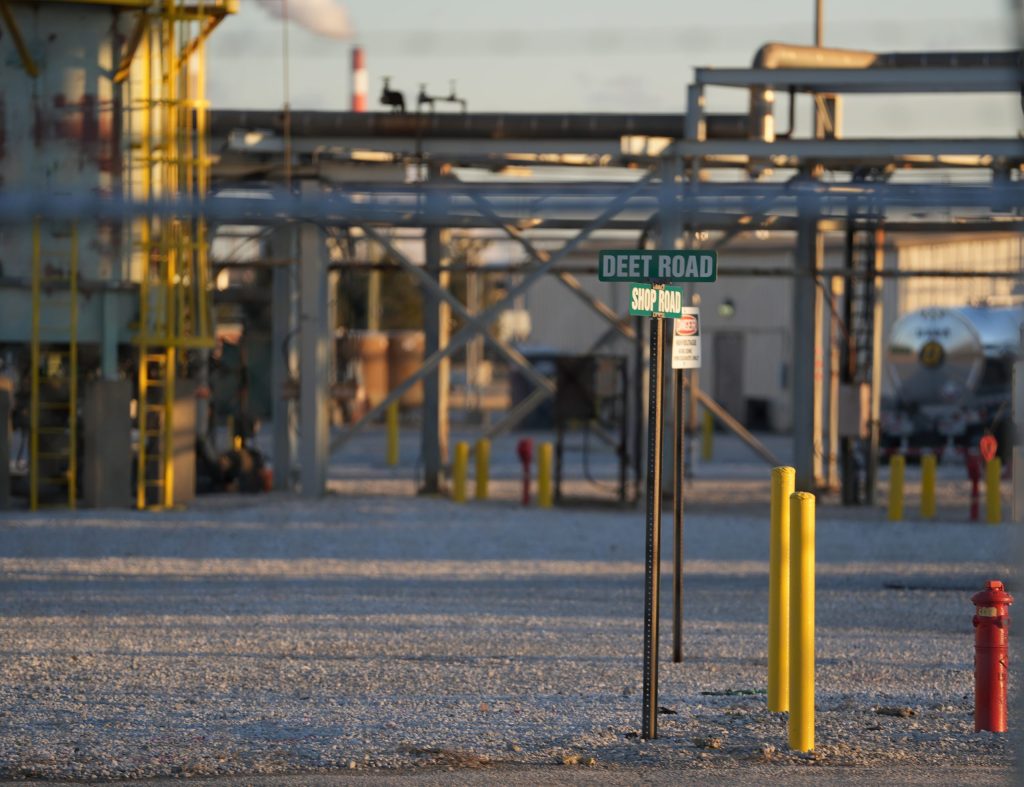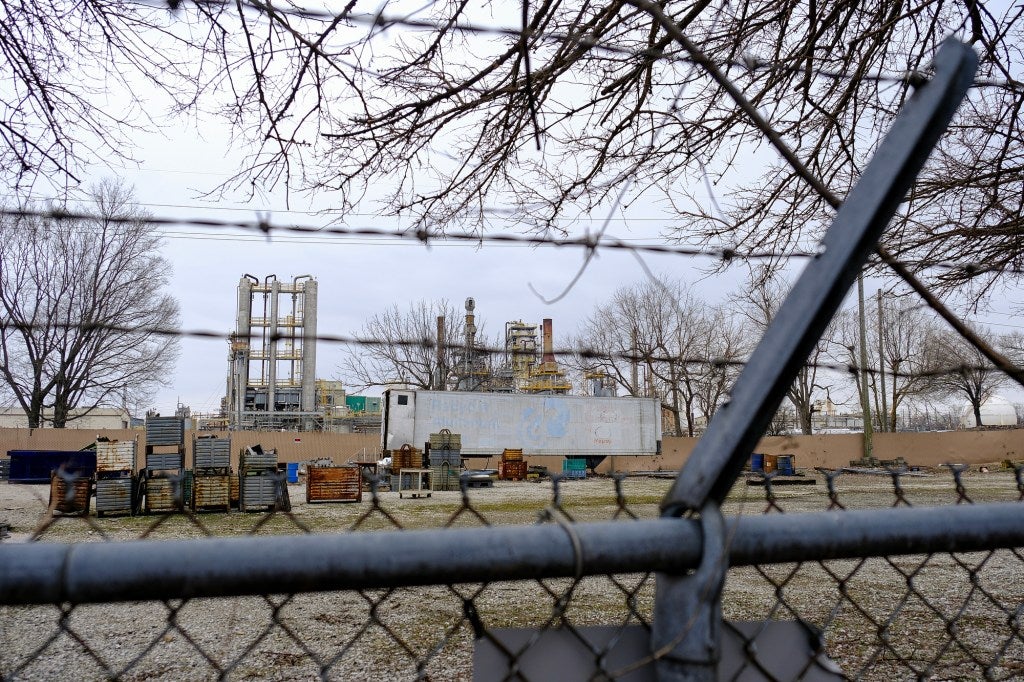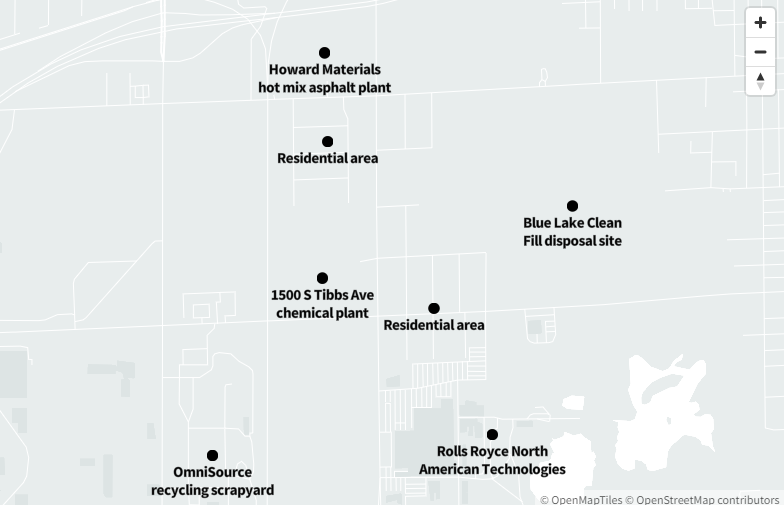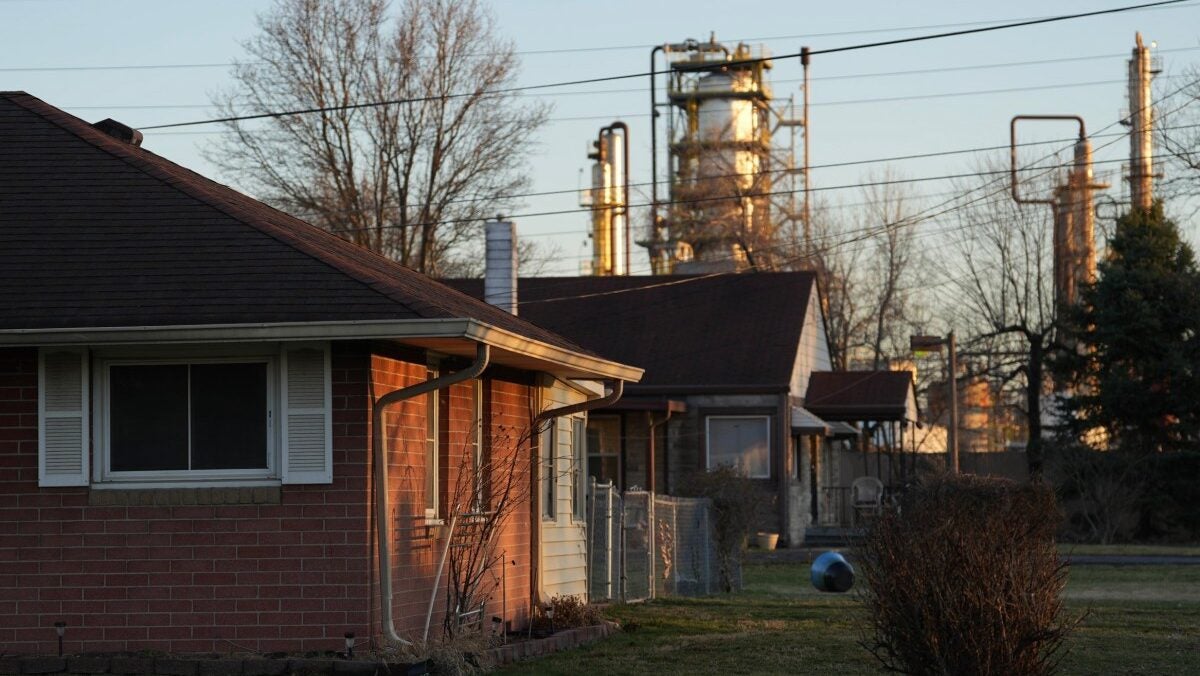A West Indy chemical plant is shutting down, and neighbors worry about the cleanup
(MIRROR INDY) — James Miller has lived about 200 feet from the fence line of a westside chemical plant for nearly 30 years. He could tell when the plant used different chemicals just by the smell.
“Sometimes it smelled like dead fish really bad,” Miller said. “It’ll make your lips tingle. Sometimes it smelled like ice cream, which is probably the one that hurts you.”
The smells match the chemical profiles of pyridines, propylene and ethylene, the top chemicals used at the plant at 1500 S. Tibbs Ave., according to the Environmental Protection Agency. Long-term exposure to the chemicals can cause neurological problems and other health issues.
The plant has cycled through multiple owners over decades, with each contributing pollution — such as toxic chemicals that infiltrate groundwater beyond the plant grounds — for at least 70 years.
But times are changing. The plant, now officially known as the 1500 South Tibbs Ave LLC plant, is closing down and no longer producing chemicals. Crews are busy decommissioning the plant and its boilers, the plant’s main source of energy production, are expected to stop operating April 1.
The smells have stopped. But the contamination remains.
The federal government struck a deal with the plant’s owner, making it responsible for cleanup of the shuttered plant and the contaminated groundwater beyond the plant grounds.
Attorneys for Aurorium, parent company of 1500 South Tibbs Ave LLC, declined to comment, telling Mirror Indy the deal “speaks for itself.”
Miller, now 67, said he was warned about the dangers of living near a chemical plant when he first moved into his home nearly three decades ago, but he’s never had any health issues. Some neighbors told him they believed the plant was the cause of some of their illnesses.
“When I bought the place, they told me that I couldn’t really have young kids run around on the grass or little dogs or whatever,” Miller said. “The guy next door told me he sold his house because of it. He said he thought it had hurt his dad and he thought it was hurting him.”
Miller and other residents living near the plant said they worry they won’t be alive to see the cleanup happen.

More than a century of pollution
The history of the chemical plant at 1500 S. Tibbs Ave. extends more than a century.
It started as Republic Creosoting Company in 1905, where it refined coal tar and coated utility poles and other items with cancer-causing creosote until 1961.
According to EPA documents, pyridines from the plant were found in the residential drinking water wells in surrounding neighborhoods beginning in 1955. It’s unclear what actions, if any, the company took to address that contamination.
The company became the Reilly Tar & Chemical Corp. in 1961, where it focused on making pyridines and other chemicals until 1989. State investigations found chemicals from the plant migrating off site again in 1964, 1975 and 1980. The EPA made the plant a Superfund site when it included it on a list of the nation’s most contaminated sites in 1984.
The Marion County Public Health Department in 1986 studied whether chemicals from the plant could be causing birth defects and miscarriages in the neighborhoods near the plant. The results were inconclusive, but the agency still recommended a cleanup.
“It is our opinion that these adverse health outcomes are probably the result of an exposure to a mixture of pollutants emanating from many industrial/residential sources,” the agency concluded in its report.
In 1987, Reilly Tar & Chemical agreed to investigate the extent of the contamination, but that same year, pollution at the site became worse. More than 60,000 gallons of fuel were spilled on the property, contaminating groundwater at the plant and in nearby neighborhoods.

That contamination is still present, with high levels of the cancer-causing chemical benzene still detected in groundwater wells.
Besides contamination from the fuel, the company’s investigation uncovered 149 drums of unidentified chemicals intentionally buried underground and high levels of toxic chemicals in the soil throughout the plant grounds. The EPA ordered a cleanup in 1994 and thousands of tons of contaminated soil were removed and replaced with clean soil, much of which was completed by 2013. A solar farm now covers about 43 acres of the plant property.
Miller said despite the cleanup efforts, yellowish material from the plant would regularly float through the air to land on vehicles in Miller’s neighborhood. He said people would come to his street and collect the material, but he didn’t know who they worked for.
“They used to come up here with a little card and an envelope, and they would scrape it up on that envelope and say, ‘It wasn’t us, but here’s a nice car wash card,’” Miller remembered.
The company changed its name to Reilly Industries and, in 2006, merged with another company to form Vertellus Specialties Inc. Vertellus declared bankruptcy in 2016 and changed hands several times until the investment firm Pritzker Private Capital purchased it in 2021.
The EPA drew up a plan that year to address the groundwater contamination, but never carried it out due to legal issues related to the multiple ownerships and the company’s bankruptcy.
The firm changed the company’s name to Vertellus Life Ingredients until July 2023, when it was changed to Aurorium Indianapolis LLC. Soon after, the company announced it was closing the plant and laid off 159 workers.
The company name was changed to 1500 South Tibbs Ave LLC in September 2023.
Skeptical about a new deal
The Justice Department struck a tentative deal with the plant’s owner to ensure it is legally responsible for its Superfund cleanup responsibilities, including addressing the groundwater contamination and plant cleanup after its decommissioning.
As part of the deal, the company will have to acquire $4.7 million in bonds, credit or other financial assurance to ensure there is enough money to finish the Superfund cleanup. If the company cannot secure the money, the deal allows the federal government to levy penalties beginning at $1,000 a day, take over the cleanup and pursue other actions to get the money owed.
The deal would also make 1500 South Tibbs Ave LLC responsible for carrying out the EPA’s plan to address groundwater contamination.
The plan is to blast pressurized air into groundwater systems to grow microorganisms that would eat the chemicals over years, a process called biosparging. The biosparging plan also calls for monitoring homes near the benzene hot spots for vapor intrusion, the term for when contaminants try to sneak out of their containment in vapor form.
Some residents living in homes where the underground benzene was detected are skeptical about whether biosparging will clean up the problem — and whether any cleanup will be attempted at all.
Betty Bittle has lived on Moreland Street, just east of the plant, for 14 years. Her home is about 200 feet from the monitoring well that detected 27.9 micrograms per liter of benzene, more than five times the limit allowed by the EPA.
She said she was unaware of the extent of the contamination. She is upset that none of the owners of the plant have cleaned up the contamination despite knowing about it since at least 1987.
“They don’t care,” Bittle said. “Money is more important than people’s lives to them, and that’s very, very wrong.”
Bittle, 69, said she’s not worried about the cleanup for herself, but for future generations, including her grandchildren. She said usually lets her grandkids play outside when they visit, but that may soon end.
“I didn’t know the chemicals were there,” she said. “I don’t trust none of these damn companies.”

The EPA and Indiana Department of Environmental Management said they believe biosparging will help address the contamination and protect the health of residents and the local environment.
The cleanup could take years to start, as it has for other Superfund sites in Indiana. It took decades for the USS Lead Superfund site in East Chicago to get cleaned up despite years of evidence that a public housing complex was built atop a former lead smelting foundry. The contamination investigation there only kicked off in earnest a decade after the state found evidence of high levels of lead in children’s blood and in soil at a nearby elementary school.
Surrounded by pollution sources
Miller and Bittle live in a portion of West Indianapolis surrounded by pollution sources that were enabled by racist and classist policies in the early part of the 20th century.
In the aftermath of the Great Depression, the U.S. government graded neighborhoods based on their financial risk to lenders. Racist and classist criteria were used in the grading process, so neighborhoods with Black, brown or certain types of white residents were given lower ratings.
The grading system, called redlining, made lower-ranking neighborhoods like West Indianapolis too risky for federal loans. Only manufacturing plants and other capital-safe projects were built there.
“This is the industrial part of town,” Miller said. “I worry about it all the time, but what can I do about it?”
Pollution on the west side of Indianapolis
People living in two pockets of residential homes are surrounded by industrial polluters.

The chemical plant was also a major source of soot pollution, also called particulate matter pollution, over the last decade. Soot is a mix of liquid droplets and particles that can, among other things, damage lungs, hearts and make existing heart and breathing problems worse.
Bittle knows the west side will never be pristine, but she wants companies to clean up the messes they are responsible for.
“They need to take responsibility,” Bittle said. “If that pollution is from some of their stuff, then take responsibility. If I screw up at work, I take responsibility. I own it. They need to take responsibility for it.”
Thoughts on the deal?
The Justice Department is accepting public comments on the proposed deal with 1500 South Tibbs Ave LLC.
To submit a public comment, email pubcomment-ees.enrd@usdoj.gov or mail your comment to Assistant Attorney General, U.S. DOJ-ENRD, P.O. Box 7611, Washington, DC 20044-7611.
Mirror Indy reporter Enrique Saenz covers west Indianapolis. Contact him at 317-983-4203 or enrique.saenz@mirrorindy.org. Follow him on X @heyEnriqueSaenz



